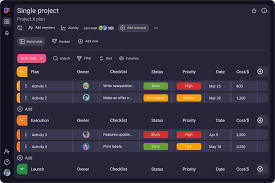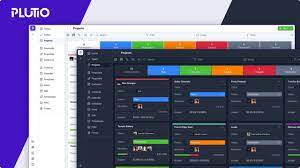Efficient Contact Management Software Solutions for Enhanced Communication
The Benefits of Contact Management Software
Contact management software is a valuable tool for businesses and individuals looking to streamline their communication processes. This type of software helps users organise, store, and manage their contacts in a centralised system, making it easier to stay connected with clients, colleagues, and other important contacts.
Key Features of Contact Management Software:
- Contact Organisation: Easily categorise and group contacts based on criteria such as job title, company, or location.
- Communication Tracking: Keep track of interactions with contacts, including emails, calls, and meetings.
- Customisable Fields: Add custom fields to store specific information relevant to your contacts.
- Integration Capabilities: Seamlessly integrate with other tools such as email clients or CRM systems.
- Reminders and Notifications: Set reminders for follow-ups or important dates related to your contacts.
The Advantages of Using Contact Management Software:
Contact management software offers numerous benefits, including:
- Improved Efficiency: Save time by easily accessing contact information and communication history in one place.
- Better Organisation: Keep your contacts organised and up-to-date for more effective relationship management.
- Enhanced Communication: Ensure timely follow-ups and personalised interactions with built-in communication tracking features.
- Data Security: Protect sensitive contact information with secure storage options and access controls.
In Conclusion
Contact management software is a valuable tool for businesses and individuals seeking to enhance their communication processes. By centralising contact information, improving organisation, and enabling efficient communication tracking, this software can help users build stronger relationships and drive business success.
Enhance Organisation and Communication with Contact Management Software: 9 Key Benefits
- Efficiently organise and categorise contacts for easy access.
- Track communication history with clients and colleagues.
- Customise fields to store specific information about contacts.
- Integrate seamlessly with other tools such as email clients or CRM systems.
- Set reminders and notifications for follow-ups and important dates.
- Improve efficiency by centralising contact information in one place.
- Enhance communication by ensuring timely follow-ups and personalised interactions.
- Maintain data security with secure storage options and access controls.
- Facilitate better organisation for effective relationship management.
Challenges of Contact Management Software: Navigating Learning Curves, Costs, and Integration Issues
Efficiently organise and categorise contacts for easy access.
Contact management software offers the pro of efficiently organising and categorising contacts for easy access. By utilising this feature, users can streamline their contact lists by grouping contacts based on specific criteria such as job title, company, or location. This not only saves time but also ensures that relevant contacts can be quickly located when needed, enhancing productivity and facilitating smoother communication processes.
Track communication history with clients and colleagues.
One significant advantage of contact management software is the ability to track communication history with clients and colleagues. By maintaining a detailed record of interactions such as emails, calls, and meetings, users can easily reference past conversations, follow-ups, and important details. This feature not only fosters better relationship management but also ensures that communication remains consistent and personalised, ultimately leading to more effective collaboration and stronger connections with contacts.
Customise fields to store specific information about contacts.
One of the key advantages of contact management software is the ability to customise fields to store specific information about contacts. This feature allows users to tailor their contact database to meet their unique needs, whether it’s capturing details like preferred communication methods, specific interests, or important dates. By customising fields, users can ensure that they have all the relevant information at their fingertips, enabling more personalised and targeted interactions with their contacts. This level of flexibility not only enhances organisation but also empowers users to build stronger relationships and improve overall communication efficiency.
Integrate seamlessly with other tools such as email clients or CRM systems.
One of the key advantages of contact management software is its ability to integrate seamlessly with other tools, such as email clients or CRM systems. This feature allows users to consolidate their contact information across multiple platforms, ensuring a unified and efficient workflow. By syncing contacts with email clients, users can easily access important contact details when composing emails or scheduling meetings. Furthermore, integration with CRM systems enables a more comprehensive view of customer interactions, empowering businesses to make data-driven decisions and provide personalised customer experiences. The seamless integration capabilities of contact management software enhance productivity and streamline communication processes for individuals and organisations alike.
Set reminders and notifications for follow-ups and important dates.
One key advantage of contact management software is the ability to set reminders and notifications for follow-ups and important dates. This feature ensures that users never miss a crucial meeting, deadline, or opportunity to reconnect with a contact. By enabling timely reminders, contact management software helps users stay proactive in maintaining relationships and managing their schedules effectively. Whether it’s scheduling a follow-up call with a client or remembering a colleague’s birthday, these reminders and notifications enhance productivity and foster stronger connections.
Improve efficiency by centralising contact information in one place.
One of the key advantages of contact management software is its ability to enhance efficiency by centralising contact information in a single, easily accessible location. By consolidating all contact details, communication history, and related notes in one place, users can save valuable time that would otherwise be spent searching through multiple sources for information. This centralisation not only streamlines the process of retrieving contact information but also ensures that users have a comprehensive view of their contacts, leading to more efficient communication and relationship management.
Enhance communication by ensuring timely follow-ups and personalised interactions.
Contact management software plays a crucial role in enhancing communication by facilitating timely follow-ups and personalised interactions. With built-in features that enable users to schedule reminders and track previous interactions, this software ensures that no important communication slips through the cracks. By providing a platform for personalised engagement based on past interactions, contact management software helps users strengthen relationships with their contacts, leading to more meaningful and productive interactions.
Maintain data security with secure storage options and access controls.
One of the key advantages of contact management software is its ability to maintain data security through secure storage options and access controls. By utilising advanced encryption methods and access restrictions, contact management software ensures that sensitive contact information is protected from unauthorised access or breaches. This feature provides users with peace of mind, knowing that their valuable data is safeguarded against potential threats, ultimately enhancing trust and confidentiality in managing contacts effectively.
Facilitate better organisation for effective relationship management.
Contact management software plays a crucial role in facilitating better organisation for effective relationship management. By centralising contact information, categorising contacts based on relevant criteria, and providing customisable fields for specific details, this software enables users to maintain a structured database of their connections. This organised approach not only saves time but also ensures that users can easily access and update contact details as needed, leading to more efficient communication and stronger relationships with clients, colleagues, and other important contacts.
Learning Curve
One significant drawback of contact management software is the learning curve it presents to new users. Navigating through the various features and functionalities of the software can be time-consuming and may require a considerable investment of effort to become proficient. This learning curve can potentially hinder quick adoption and usage of the software, especially for individuals and businesses looking for immediate improvements in their contact management processes.
Cost
One significant drawback of contact management software is the potential cost involved. Certain solutions can be expensive, posing a financial challenge for small businesses or individuals operating on limited budgets. The upfront investment required for these software packages may deter some users from accessing the benefits of streamlined contact organisation and communication tracking, ultimately limiting their ability to leverage such tools effectively in their day-to-day operations.
Integration Challenges
Integration Challenges: One significant drawback of contact management software is the potential difficulty in integrating it with existing tools or systems already in use by the user. Depending on the chosen software, compatibility issues may arise, leading to disruptions in workflow and communication. This can result in additional time and resources being spent on resolving integration challenges, impacting overall efficiency and productivity. Users should carefully consider the compatibility of contact management software with their current systems before implementation to mitigate these integration hurdles.





